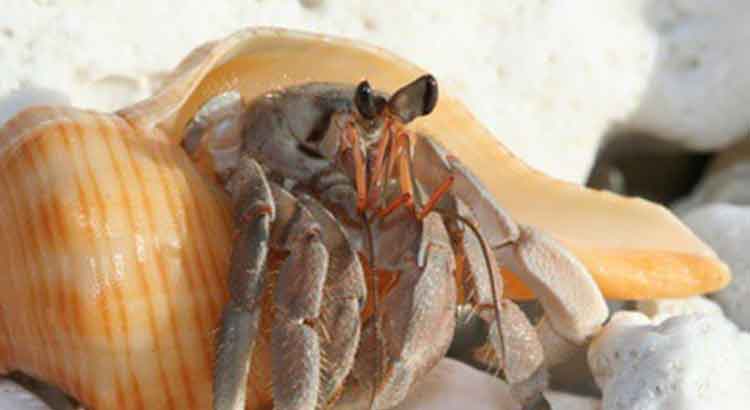Ever wondered how hermit crabs navigate their world? Let’s uncover the mystery of their unique sideways walk and whether they ever stroll forward or backward.
Hermit crabs predominantly walk sideways due to their anatomical structure and movement patterns. Their bodies are adapted for this side-to-side motion, which helps protect their vulnerable abdomen and allows for efficient movement in their shell homes.
Exploring the intriguing world of hermit crab locomotion reveals fascinating insights into their behavior and adaptation. Join us as we delve deeper into the secrets of these captivating crustaceans’ walking habits.
Lateral Movement
Hermit crabs are masters of lateral movement, thanks to their unique body structure. Their abdomen is curled to one side, fitting snugly into their shell. This design allows them to move sideways with ease, utilizing their powerful legs and jointed exoskeleton to scuttle across various terrains effortlessly.
While hermit crabs predominantly walk sideways, they can also move backward or forward when necessary. However, this occurs less frequently and is usually in response to specific stimuli or environmental conditions. Forward or backward movement requires more effort and coordination due to their sideways orientation.
Understanding the mechanics behind hermit crab locomotion sheds light on their fascinating adaptation to life in shells. Their sideways walk not only aids in protection but also facilitates exploration and foraging in their coastal habitats. Observing these crustaceans in action offers a glimpse into the intricate balance between mobility and safety in their daily lives.
Forward Mobility
Although hermit crabs primarily move laterally, they can exhibit forward mobility when prompted. This forward movement typically occurs when they need to navigate obstacles or search for food in tight spaces. While not their preferred mode of travel, hermit crabs demonstrate impressive flexibility and adaptability in their quest for survival.
In certain situations, such as when seeking new shells or escaping predators, hermit crabs may opt for forward mobility. However, this mode of travel requires more energy expenditure and may be less efficient than their usual sideways walk. Nonetheless, their ability to switch between movement patterns highlights the resourcefulness of these fascinating creatures.
Adaptive Strategies
Hermit crabs employ various adaptive strategies to navigate their environment efficiently. Their ability to move sideways allows them to maneuver through narrow passages and scavenge for food along the coastline. Additionally, their reliance on lateral movement helps them avoid predators by quickly retreating into their shells when threatened.
Incorporating both lateral and occasional forward movement, hermit crabs adapt their locomotion based on environmental cues. When faced with obstacles or unfamiliar terrain, they may switch between these strategies to overcome challenges and explore new territories. This versatility underscores their remarkable ability to thrive in diverse coastal ecosystems.
Hermit crabs are highly attuned to environmental influences that shape their behavior and movement patterns. Factors such as substrate type, temperature, and humidity levels can significantly impact their locomotion. For instance, sandy beaches provide ideal conditions for sideways walking, while rocky shores may necessitate more cautious navigation. Understanding these environmental influences is crucial for studying the behavioral ecology of these fascinating crustaceans.
FAQ
Can hermit crabs walk forward or backward?
Yes, hermit crabs can walk forward or backward, although they primarily move sideways. Their ability to navigate in various directions allows them to adapt to different situations, such as avoiding predators or searching for food.
Why do hermit crabs walk sideways?
Hermit crabs walk sideways primarily due to their anatomical structure. Their curved abdomen fits snugly into their shell, making sideways movement more natural and efficient. This sideways walk also helps protect their vulnerable abdomen while providing stability on uneven terrain.
Do hermit crabs ever walk in a straight line?
While hermit crabs generally prefer lateral movement, they may occasionally walk in a straight line, especially when exploring open areas or following scent trails. However, this behavior is less common compared to their sideways scuttling.
How do hermit crabs change shells if they walk sideways?
When hermit crabs change shells, they often temporarily straighten their bodies to facilitate the transition. This allows them to maneuver into a new shell while minimizing the risk of getting stuck or injured. Once they’ve settled into the new shell, they resume their sideways walk.
Can hermit crabs walk backward faster than forward?
Hermit crabs can walk backward faster than forward, thanks to their jointed legs and flexible exoskeleton. When moving backward, they use their powerful back legs to propel themselves with greater speed and agility, allowing for quick escapes from predators or tight spaces.
What factors influence the direction of hermit crab movement?
Several factors influence the direction of hermit crab movement, including environmental conditions, sensory cues, and behavioral responses. For example, they may walk sideways to navigate rocky terrain or switch to forward movement when chasing prey or exploring new habitats.
Final Thoughts
Understanding the intricate world of hermit crab locomotion offers valuable insights into the adaptability and resilience of these fascinating crustaceans. While their sideways walk is their preferred mode of movement, hermit crabs demonstrate flexibility by occasionally walking forward or backward when necessary. This versatility underscores their ability to thrive in diverse coastal environments, where they must navigate various obstacles and challenges to survive.
Observing hermit crabs in their natural habitat provides a glimpse into the complex interplay between anatomy, behavior, and environmental factors. Their sideways walk, shaped by evolutionary adaptations, not only facilitates efficient movement but also serves as a protective mechanism against predators. By studying the nuances of their locomotion, researchers gain a deeper appreciation for the interconnectedness of biological processes and ecological dynamics in coastal ecosystems.
In conclusion, the sideways walk of hermit crabs is a testament to their remarkable ability to adapt and thrive in dynamic marine environments. While their unique movement patterns may seem simple at first glance, they reflect a sophisticated integration of physiological, behavioral, and environmental factors. By continuing to explore and understand the intricacies of hermit crab locomotion, we can further unravel the mysteries of these captivating creatures and their role in shaping coastal ecosystems.

